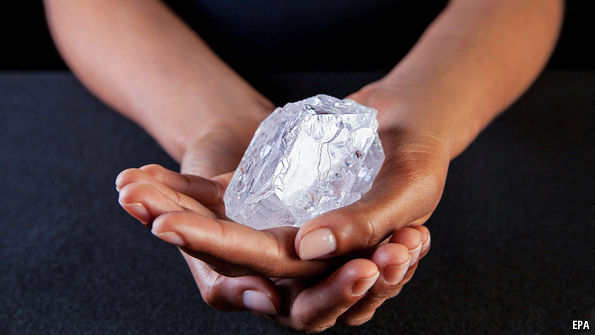Real is Rare July 16 2016

The Lesedi La Rona, a stunning diamond we featured in one of our earlier blogs, has had an epic journey. Forged by the brute forces of Nature almost 2.5 billion years ago, it had risen through the chasms of inner Earth and lay hidden on the surface for millennia. As humans evolved, as empires and nations formed and crumbled, as the world’s technology developed, the Lesedi La Rona stood patiently awaiting its discovery. The grand scale of time and power witnessed by diamonds grant them a unique mystique but not even that could avoid the paltry result of its auction held last week at Sotheby’s.
The 1,109-carat Lesedi La Rona failed to even make the $70 million reserve as a wave of disappointment spread across the auction floor in London. The diamond industry had little to celebrate but attributed a key set of factors contributing to the meager bidding levels for a diamond placed at the same league as the 3,107-carat Cullinan Diamond found in 1905; The rapidly developing technological landscape, the socially aware consumer and the wake of an evolving financial industry.
New technology has paved the way to the creation of synthetic diamonds that are becoming increasingly widespread in its use. They are usually formed in laboratories utilizing large mechanical presses that simulate the incredibly heavy pressures and high temperatures found deep underground, or a process known as chemical vapor deposition that literally grow diamonds one carbon atom at a time. As the development of this technology improves and the high costs of R&D gradually decline, these synthetic diamonds will begin to become competitive in the jewelry market just as it has dominated the market for industrial use.
The use of this new technology feeds into the second factor contributing to the hesitance experienced by more auctions across the world. Man-made diamonds simply eliminate the prospect of having to worry about whether the diamond a consumer has purchased is being used to finance warfare and other humanitarian crises. True, the 2003 Kimberly Process Certification scheme helped screen out a large portion of these illicit trades, but the intricacies of the system have allowed regulators to focus much of their attention only to diamonds funding rebel armies. Consumer awareness, buttressed by Hollywood glamor and the likes of Leonardo DiCaprio in ‘Blood Diamond’, make it much more hassle free for consumers to choose diamonds from a lab than to risk the off chance of purchasing a mined diamond from conflict areas. The sales of synthetic diamonds are still miniscule compared to the $14 billion of rough diamonds sold each year, but it represents an interesting and noteworthy trend.
The third factor relates to new regulations implemented within the global financial industry at the close of the financial crisis in 2009. Enhanced transparency and tighter credit standards have made lenders such as Standard Chartered, an emerging markets bank, to cut their $2 billion exposure to the diamond financing segment. Stricter trading terms have indeed lowered the tolerance for risk and many players within the industry are adjusting to the new norm by scaling back their purchases.
The resonance of ‘A Diamond is Forever’ appears to be fading but as is with change, market innovators are emerging. They appear to stand behind the call of ‘Real is Rare’ to appeal to millennials who show a marked inclination for authenticity. A dash for origin certifications is compounding within the industry as they try to keep their sparkle and we expect this age old trade to experience many changes to meet the needs of the contemporaneous consumer. The Lesedi La Rona may not have met its expectations last week, but it surely lit the path to a new era within the diamond industry.
